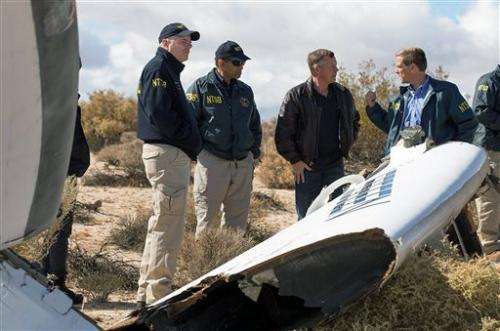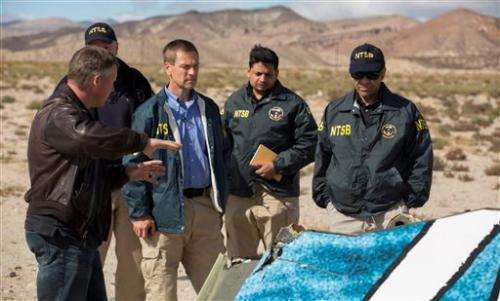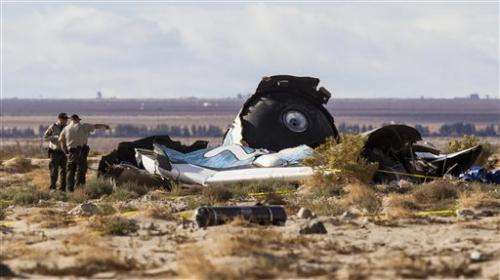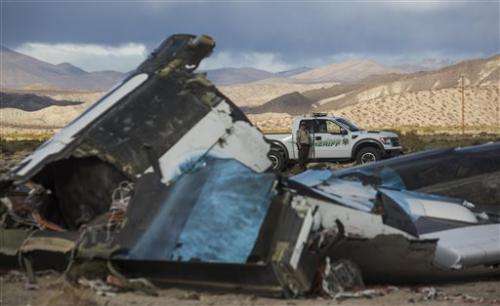Many questions still unanswered in spaceship crash

Federal accident investigators have an early sense of what went wrong before an experimental spaceship designed to carry tourists beyond the Earth's atmosphere broke apart during a test flight. But they still don't know why the craft prematurely shifted its shape prior to the deadly crash.
Another question looms: How far will the accident push back the day when paying customers can routinely rocket into the sky for a fleeting feel of weightlessness and a breathtaking view?
A team from the National Transportation Safety Board kept working Monday at the Mojave Desert crash site where Virgin Galactic's SpaceShipTwo fell to the ground. The accident killed the co-pilot and badly injured the pilot, who parachuted out of the ship Friday.
Late Sunday, acting NTSB Chairman Christopher Hart said cockpit video showed that the co-pilot unlocked SpaceShipTwo's unique "feathering" system earlier than planned. The system works somewhat like the wing flaps that airplanes use to slow for landing—except that SpaceShipTwo's twin tails rotate up at a far more extreme angle, to a position that creates strong resistance and slows the descent.
But while the co-pilot unlocked the system before planned, that action alone should not have been enough to change the craft's configuration. Activating the feathering system requires the pulling of a lever. It's not unlike when a gun fires only when the trigger is pulled, not just because the safety has been disengaged.
Questions abound: Why did the co-pilot unlock the feathering system at that moment? Why did the tails begin to rotate without the co-pilot starting that process?
NTSB spokesman Peter Knudson said Monday that investigators believe once the feathers were unlocked, "aerodynamic forces" buffeting the craft as it hurtled along at about 760 mph (1,225 kph) caused the feathers to start rotating. Within two seconds, the craft began to disintegrate, NTSB investigators determined.
SpaceShipTwo is carried aloft on the underside of a jet-powered mother ship. It then drops from that ship and fires its own rocket to head higher. Only when it reaches at least Mach 1.4, or more than 1,000 mph, are the feathers supposed to engage, the NTSB's Hart told reporters.

Knudson stressed that a final cause will take months to determine, and that investigators were looking into other factors, including pilot training, mechanical failure and design flaws.
Passenger jets typically fly at about seven miles (11 kilometers) high. Virgin Galactic envisions flights with six passengers climbing to more than 62 miles above Earth. Seats sell for $250,000, and the company says it has booked passengers including Justin Bieber, Ashton Kutcher and Russell Brand.
The ultimate goal of Virgin Galactic co-owner Richard Branson is to create an industry that can move people around the globe in a fraction of the current time it takes passenger jets, by rocketing them into space and back down.
SpaceShipTwo has been under development for years, and Branson originally predicted passengers would be enjoying the wonders of flight by now. In the weeks before the crash, he said he hoped to fly in 2015.
Branson still plans to be on the maiden voyage, with his family. He said that day will not come before a new round of crew-only flights.
"We need to be absolutely certain our spaceship has been thoroughly tested—and that it will be," he said. "And once it's thoroughly tested, and we can go to space, we will go to space."

Friday's crash could trigger increased government regulation.
To give the fledgling commercial space industry space to innovate, the Federal Aviation Administration has not overregulated test flights during the past decade, according to Diane Howard, an assistant professor at Embry-Riddle Aeronautical University who specializes in space law.
But the crash could allow the FAA to propose new rules that would affect future flights, and "it will be very interesting to see how Congress and the FAA and industry respond," Howard said.

The FAA did not immediately comment Monday. The agency is able to initiate a rule-making process that would affect the design or operation of a spacecraft involved in a fatal accident, but is unlikely to do so before the end of the NTSB's investigation.
© 2014 The Associated Press. All rights reserved.



















